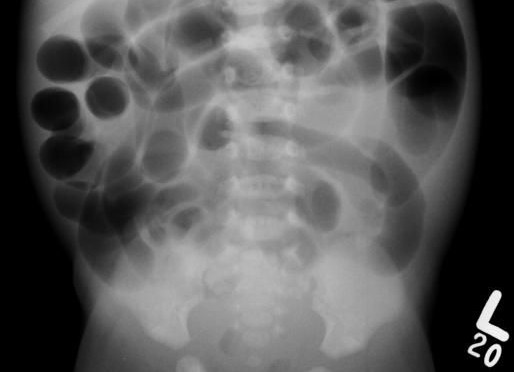Author: Geoff Jara-Almonte, MD (PEM Fellow, New York Methodist Hospital) // Edited by: Jennifer Robertson, MD, MSEd and Alex Koyfman, MD (@EMHighAK, EM Attending Physician, UTSW / Parkland Memorial Hospital)
The computed tomography (CT) scan is a commonly utilized test for abdominal pain in the emergency department (ED). CT is so ubiquitous in the evaluation of abdominal pain in the ED that it sometimes seems as though the scan is done prior to physician evaluation. But CT is not the best test for everyone as it involves a relatively large dose of ionizing radiation, which can cause harm to a developing fetus. CT is also theorized to be associated with an increased risk of cancer in children. Additionally, some specific pediatric complaints are better evaluated, at least initially, with other diagnostic studies.
Case 1: A 10 year-old previously healthy boy presents with 16 hours of abdominal pain that was initially periumbilical, but is now worse in the right lower quadrant (RLQ). His pain is also associated with nausea, vomiting and anorexia without any diarrhea. He lies still in bed and tenses with any abdominal palpation. He will jump up and down, but he seems to be in significant pain.
Appendicitis is a notoriously difficult-to-diagnose condition, particularly in children and pregnant patients. Missed appendicitis is the most common cause of lawsuits in cases with patients aged 6-17 years.[i] Children, especially younger children, are more likely to present late in the course of the disease or with a perforated appendicitis.
In the case of the pediatric patient with suspected appendicitis in whom the diagnosis remains equivocal after physical exam and laboratory testing, imaging is indicated. The American College of Radiology (ACR) recommends ultrasound of the abdomen as the most appropriate first test in evaluating appendicitis.[ii] The American College of Emergency Physicians (ACEP) recommends using ultrasound to rule-in appendicitis, and using CT of the abdomen and pelvis to exclude appendicitis.i
A positive ultrasound has a high positive likelihood ratio for the diagnosis of appendicitis. However a negative ultrasound generally has inadequate sensitivity to rule out appendicitis, and equivocal studies or non-visualization of the appendix are common. In the case of an equivocal ultrasound a CT is the recommended next step. Contrast is generally favored in CT for appendicitis, however, adequate studies in the pediatric population are lacking.i
Magnetic resonance imaging (MRI) has good sensitivity for appendicitis in children however it is not recommended as a routine study due to limitations including duration of study, need for sedation, and limited experience in most centers.ii
Case 1b: 26 year-old pregnant G1P0 at 14 weeks by last menstrual period (LMP) complains of lower abdominal pain, worse on the right side for the past two days. She has had nausea and vomiting without diarrhea. She has had no dysuria, fever, vaginal bleeding or discharge.
The use of ionizing radiation in pregnant patients is particularly concerning because of the radiosensitivity of the developing fetus. MRI and ultrasound are safe in pregnancy and are the favored means of abdominal imaging in pregnancy. The ACR recommends abdominal ultrasound and/or MRI as the most appropriate tests in the pregnant patient with RLQ pain suspicious for appendicitis or acute non-localized abdominal pain and fever.ii, [iii] ACEP’s guidelines on the evaluation of suspected appendicitis specifically exclude pregnant patients.i
The American College of Obstetrics and Gynecology (ACOG) guidelines for diagnostic imaging during pregnancy do not address specific clinical conditions or suggest any particular imaging algorithms. ACOG recommends that when available and appropriate, ultrasound and MRI should be used preferentially. However, the society adds the following recommendation:
With few exceptions, radiation exposure through radiography, computed tomography scan, or nuclear medicine imaging techniques is at a dose much lower than the exposure associated with fetal harm. If these techniques are necessary in addition to ultra-sonography or magnetic resonance imaging or are more readily available for the diagnosis in question, they should not be withheld from a pregnant patient.[iv]
Case 2: A 3 week-old female is brought in by her concerned parents after vomiting up “green stuff” twice this afternoon. The patient is the product of a term pregnancy, born by normal vaginal delivery without complications. Up to this point, she has been breast feeding 15-20 minutes every two hours without any issues.
Acute bilious vomiting in a child under a year of age should raise suspicion for malrotation with midgut volvulus. Malrotation is a congenital condition of inappropriate fixation of the mesentery. The bowel may rotate about the points of abnormal fixation leading to obstruction, ischemia, and necrosis of the bowel.
The presentation of midgut volvulus may include acute bilious vomiting, with or without abdominal pain. However, it may also demonstrate gradually progressive vomiting. Abdominal tenderness and distention may or may not be present. Plain radiographs may show a classic “double bubble sign” with gaseous distention of the stomach and duodenum and paucity of air elsewhere. However, plain films may also be show non-specific findings or be completely normal.
Some textbooks recommend a rapid abdominal x-ray as the initial study of choice for diagnosing midgut volvulus[v], however the ACR recommends an upper gastrointestinal (GI) series as the initial diagnostic study.[vi] The GI series will show an abnormally positioned duodenum and an absent ligament of Treitz. Approximately 25% of cases of malrotation are diagnosed in children over 1 year of age. These may present with acute bilious vomiting or recurrent intermittent episodes of abdominal pain and vomiting. CT of the abdomen and pelvis has demonstrated high sensitivity for malrotationvii but is not part of the ACR recommendations for criteria for children under 3 months; consensus guidelines are lacking for evaluation in children outside of this age group.
Case 3a: A 5 week-old infant is brought in for vomiting. The parents report he has been vomiting after every feed for the past 5 days. Initially, they thought he was spitting up, but now it has become projectile. The emesis consists of milk and is non-bloody and non-bilious. Immediately after vomiting, the patient is hungry again and tries to feed.
New onset non-bilious vomiting in the first several weeks of life should raise suspicion for hypertrophic pyloric stenosis. This occurs more commonly in males and firstborn children. Both an upper GI series and/or abdominal ultrasound can show real-time transit through the pyloric channel.
The ACR recommends abdominal ultrasound as the most appropriate initial study for diagnosing pyloric stenosis. A thickened and elongated pylorus can be visualized on ultrasound, and real-time evaluation can demonstrate a failure to pass gastric contents. The ACR allows that in some centers with less experience with pyloric ultrasound, or in atypical cases, upper GI series may be an appropriated first study.
Case 3b: An 11 month-old infant has had two uncharacteristic episodes of inconsolable screaming at home. The first one lasted about 20 minutes and resolved spontaneously. After this first episode, she was fine, happy and playful. However, about 2 hours later, the patient had a second episode and thus, her parents brought her to the ED. On the way to the ED, the crying resolved and she became once again, happy, curious, and playful. She has had no fever, cough, vomiting, or diarrhea. She did have a cold one week ago.
The history of intermittent colicky episodes of screaming are suspicious for the diagnosis of intussusception. In the pre-verbal child, a history of abdominal pain cannot be elucidated, but parents may report drawing of the knees to the chest. Bloody or “currant jelly” stools and vomiting are late findings as bowel ischemia and obstruction progress. Parents may also note pallor and lethargy during these periods. Children may have no symptoms between episodes. The frequency and intensity of colicky episodes typically progresses.
Consensus guidelines for the best initial study in the diagnosis of intussusception are lacking. Plain abdominal X-ray has poor sensitivity and specificity for the condition, though it is useful to rule out free air. Plain abdominal x-ray may also demonstrate a paucity of bowel gas in the RLQ or a target sign. Abdominal ultrasound has very high (near 100%) sensitivity and specificity for intussusception. Typically, ultrasound is the initial test of choice. Air or contrast enema under fluoroscopic guidance can also be used to diagnose and reduce an intussusception, either as an initial study or following a diagnostic ultrasound.
References / Further Reading
[i] Howell, John M., et al. “Clinical policy: critical issues in the evaluation and management of emergency department patients with suspected appendicitis.” Annals of emergency medicine 55.1 (2010): 71-116.
[ii] American College of Radiology – ACR Appropriateness Criteria: Right Lower Quadrant Pain – Suspected Appendicitis; https://acsearch.acr.org/docs/69357/Narrative/
[iii] American College of Radiology – ACR Appropriateness Criteria: Acute (Nonlocalized) Abdominal Pain and Fever or Suspected Abdominal Abscess https://acsearch.acr.org/docs/69467/Narrative/
[iv] Guidelines for diagnostic imaging during pregnancy and lactation. Committee Opinion No. 656. American College of Obstetricians and Gynecologists. Obstet Gynecol 2016;127:e75–80.
[v] Fleisher, Gary R., and Stephen Ludwig, eds. Textbook of pediatric emergency medicine. Lippincott Williams & Wilkins, 2010.
[vi] American College of Radiology – ACR Appropriateness Criteria: Vomiting in Infants up to Three Months of Age; https://acsearch.acr.org/docs/69445/Narrative/
viiTackett JJ, Muise ED, Cowles RA. Malrotation: Current strategies navigating the radiologic diagnosis of a surgical emergency. World Journal of Radiology. 2014;6(9):730-736. doi:10.4329/wjr.v6.i9.730.







1 thought on “Guidelines for Imaging: Abdominal Pain in the Pediatric and Gravid Populations”
Pingback: Länkar v17-19 | Internmedicin